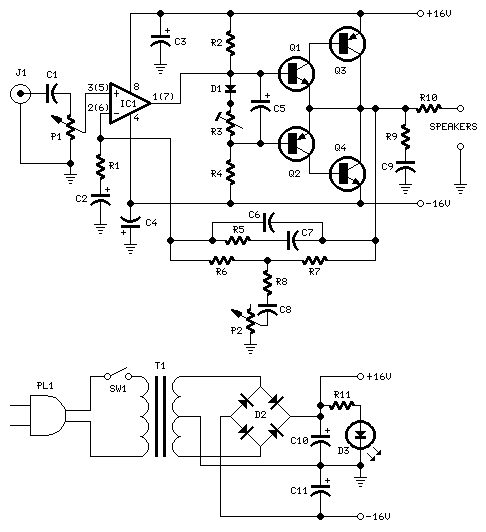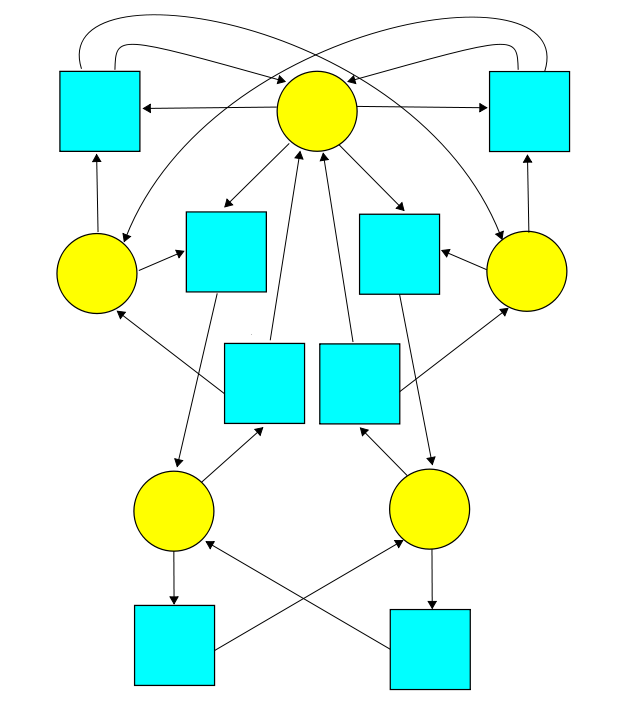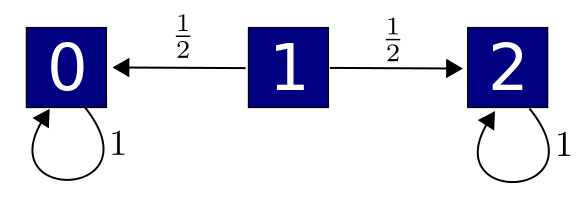Network Theory (Part 16)
We’ve been comparing two theories: stochastic mechanics and quantum mechanics. Last time we saw that any graph gives us an example of both theories! It’s a bit peculiar, but today we’ll explore the intersection of these theories a little further, and see that it has another interpretation. It’s also the theory of electrical circuits made of resistors!That’s nice, because I’m supposed to be talking about ‘network theory’, and electrical circuits are perhaps the most practical networks of all:

Dirichlet operators
Last time we saw that any graph gives us an operator called the ‘graph Laplacian’ that’s both infinitesimal stochastic and self-adjoint. That means we get both:• a Markov process describing the random walk of a classical particle on the graph.
and
• a 1-parameter unitary group describing the motion of a quantum particle on the graph.
That’s sort of neat, so it’s natural to wonder what are all the operators that are both infinitesimal stochastic and self-adjoint. They’re called ‘Dirichlet operators’, and at least in the finite-dimensional case we’re considering, they’re easy to completely understand. Even better, it turns out they describe electrical circuits made of resistors!
Today let’s take a lowbrow attitude and think of a linear operator
•
•
•
What are Dirichlet operators like? Suppose
its diagonal entries obey
So all the entries of the matrix
So, we can build any Dirichlet operator
• Choose the entries above the diagonal,
• The entries below the diagonal,
• The diagonal entries are then forced on us by the requirement that the columns sum to zero:
Note that because the entries are real, we can think of a Dirichlet operator as a linear operator
Circuits made of resistors
Now for the fun part. We can easily draw any Dirichlet operator! To this we draw

Theorem. Any finite simple graph with edges labelled by positive numbers gives a Dirichlet operator, and conversely.
We already talked about a special case last time: if we label all the edges by the number 1, our operator
What’s the meaning of this trick? Well, we can think of our graph as an electrical circuit where the edges are wires. What do the numbers labelling these wires mean? One obvious possibility is to put a resistor on each wire, and let that number be its resistance. But that doesn’t make sense, since we’re leaving out wires labelled by 0. If we leave out a wire, that’s not like having a wire of zero resistance: it’s like having a wire of infinite resistance! No current can go through when there’s no wire. So the number labelling an edge should be the conductance of the resistor on that wire. Conductance is the reciprocal of resistance.
So, our Dirichlet operator above gives a circuit like this:

Let’s see if this cute idea leads anywhere. Think of a Dirichlet operator
Now, what’s
In quantum mechanics this would be a very sensible thing to look at: it would be gives us the expected value of the Hamiltonian
Up to a constant fudge factor, it turns out to be the power consumed by the electrical circuit!
Let’s see why. First, remember that when a current flows along a wire, power gets consumed. In other words, electrostatic potential energy gets turned into heat. The power consumed is
where
so
If we write this using the conductance instead of the resistance
But our electrical circuit has lots of wires, so the power it consumes will be a sum of terms like this. We’re assuming
This is nice, but what does it have to do with
The answer is here:
Theorem. If
Proof. Let’s start with the formula for power:
Note that this sum includes the condition
Expanding the square, we get
The middle term looks promisingly similar to
And in fact they’re zero! Since
so
and it’s still zero when we sum over
But since
So, we’re done. █
An instant consequence of this theorem is that a Dirichlet operator has
for all
which is nice. When
The big picture
Maybe it’s a good time to step back and see where we are.So far we’ve been exploring the analogy between stochastic mechanics and quantum mechanics. Where do networks come in? Well, they’ve actually come in twice so far:
1) First we saw that Petri nets can be used to describe stochastic or quantum processes where things of different kinds randomly react and turn into other things. A Petri net is a kind of network like this:

2) Then we looked at stochastic or quantum processes where in each transition a single thing turns into a single thing. We can draw these as Petri nets where each transition has just one state as input and one state as output. But we can also draw them as directed graphs with edges labelled by numbers:

Today we looked at a special case of the second kind of network: the Dirichlet operators. For these the ‘forward’ transition rate

• Stochastic mechanics:
• Quantum mechanics:
• Circuits made of resistors:
This dictionary may seem rather odd—especially the third item, which looks completely different than the first two! But that’s good: when things aren’t odd, we don’t get many new ideas. The whole point of this ‘network theory’ business is to think about networks from many different viewpoints and let the sparks fly!
Actually, this particular oddity is well-known in certain circles. We’ve been looking at the discrete version, where we have a finite set of states. But in the continuum, the classic example of a Dirichlet operator is the Laplacian
• The heat equation:
is fundamental to stochastic mechanics.
• The Schrödinger equation:
is fundamental to quantum mechanics.
• The Poisson equation:
is fundamental to electrostatics.
Briefly speaking, electrostatics is the study of how the electric potential
I’ll say a lot more about this… but not today! If you want to learn more, this is a great place to start:
• P. G. Doyle and J. L. Snell, Random Walks and Electrical Circuits, Mathematical Association of America, Washington DC, 1984.
This free online book explains, in a really fun informal way, how random walks on graphs, are related to electrical circuits made of resistors. To dig deeper into the continuum case, try:
• M. Fukushima, Dirichlet Forms and Markov Processes, North-Holland, Amsterdam, 1980.

0 comments:
Post a Comment